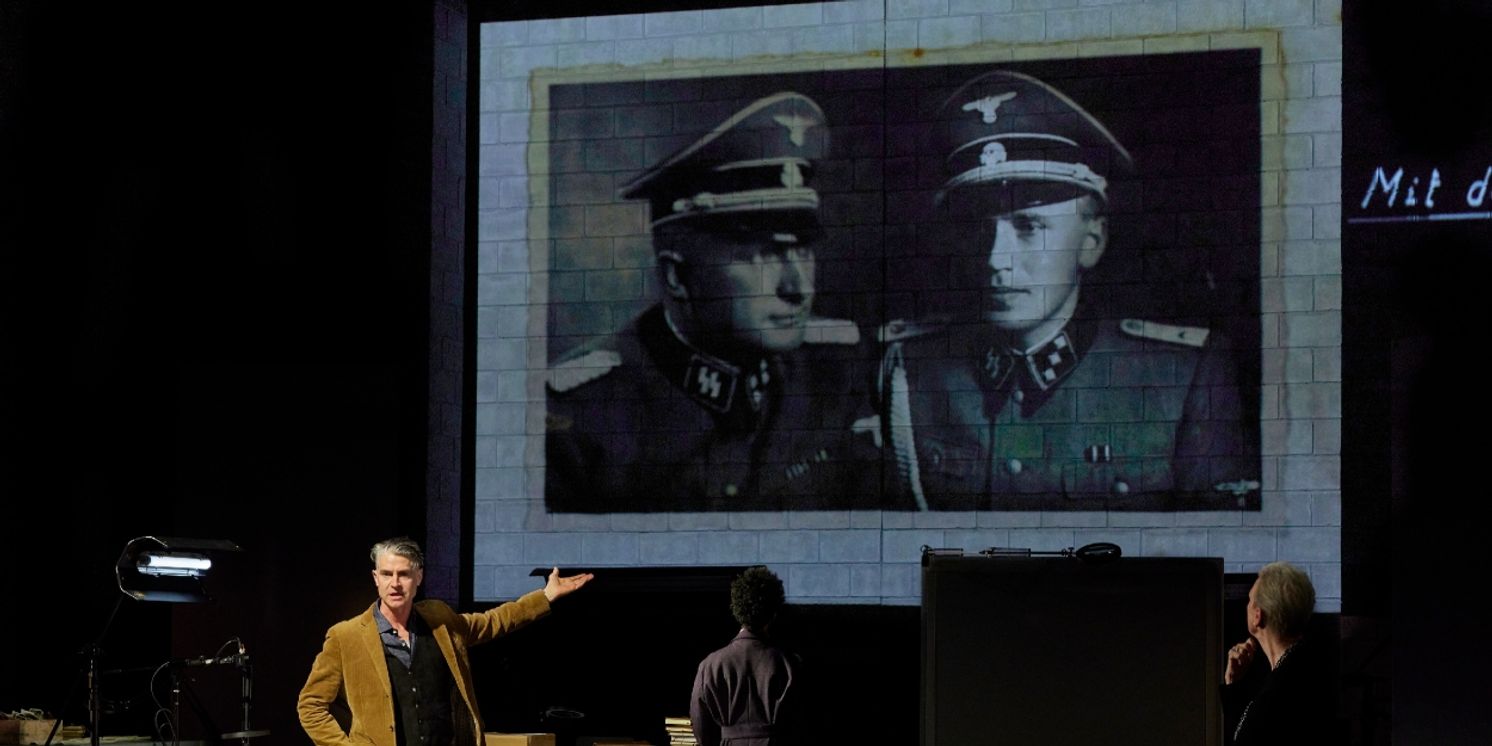Review: HERE THERE ARE BLUEBERRIES at Tectonic Theater Project at Shakespeare Theatre's Harman Hall
A documentary play uses Epic Theatre to consider an unanswerable question of the Holocaust

Moviegoers of a certain age may have first felt and learned what the Nazis did to people during the Holocaust from the emotion-filled performances of Judy Garland, Montgomery Clift, and Marlene Dietrich in the 1961 film, Judgment at Nuremberg. Fictionalization has its strengths. Here There Are Blueberries, a documentary theatre piece by the Tectonic Theater Project, finds stronger strengths in distancing an audience from emotion and enabling facts to do the work. The play's part of this true story began in 2006 when Dr. Rebecca Erbelding, who worked as an archivist at the United States Holocaust Memorial Museum here in DC, heard from an American military officer who found a photo album while posted to Frankfurt, Germany during the run-up to the first trials of Nazi war criminals which began in 1946.
The photo album contained 116 photos of German soldiers and a few civilians along with some handwritten captions; eventually Erbelding and her colleagues were able to contextualize the 37 pages of photographs which are of the men and women who operated Auschwitz. The photos were taken in and around the camp and had never previously been seen. Why the American soldier kept it hidden for 60 years remains an unanswered question. But the museum's work determined that the album was created by a junior officer in the SS named Karl Höcker whose job as assistant to the concentration camp's leader included record-keeping of several sorts, including compiling photos of his fellow soldiers, office and staff workers at the camp, senior officers who visited Auschwitz, and the families of officers whose rank privileged them to have their wives and children on-site. The play that Moisés Kaufman and Amanda Gronich have devised about the album and the people in the photographs in it is simply riveting.
David Bengali's projection design helps make the photographs the star of the show. They're there for great lengths of time, often in several sizes, filling the back wall of Harman Hall. Bengali has arranged a highlight function so that details being talked about visually pop. Kaufman, in his other role as director, times the projections with precision, achieving perfect balance between people onstage speaking and pictures up there saying nothing, while, of course, being worth so very many words. David Lander's lighting helps with this process too--singling out one or two actors at times and going full-court fluorescent in the Holocaust Museum's work room. At no time do his lights bleed into Bengali's projections. Unfortunately, Bobby McElver's sound design hemorrhages more than it contributes. Once the sound of a camera shutter, a keyboard, or a spoon on a bowl has been recorded, reproduced, amplified, and leveled, it no longer sounds like a real object; in a documentary, "sound effects" constitute fake news.
The sterling, eight-actor ensemble portray many more than eight people during this vast play which somehow fits into 90, intermission-less minutes. Their refreshingly detached style matches the photographs: they just are. Because Here There Are Blueberries is a true story, to "interpret" it could falsify it. This acting team lets an audience think and feel independently without implying how it ought to think or feel. Nevertheless, audiences will see plenty of what only actors can do. Maboud Ebrahimzadeh has a surprised kind of energy as Tilman Taube, a German who spotted his grandfather in the photo album when the finding of the album made German newspapers. Charlie Thurston reveals the torment of being a tormentor's descendant in his portrayal of Rainer Höss, grandson of Rudolf Höss. As Peter Wirths, the son of the SS doctor who served as the chief medical officer at Auschwitz, Grant James Varjas evokes what it was like to see himself as a child in photos in the album. Elizabeth Stahlmann's articulate and businesslike Dr. Erbelding contrasts with her rendering of Lily Jacob, a Holocaust survivor who tells her own photo album story.
For Broadway theatregoers of a certain age, Here There Are Blueberries bookends what the Nazis did at Auschwitz with Peter Weiss' The Investigation (1965), a documentary which ran in New York in 1966 and undoubtedly contains the words (they're denials) of Karl Höcker's testimony at the Frankfurt-Auschwitz Trials of 1963-1965. Kaufman and Gronich incorporate information about both of Höcker's trials as well as footage of him arriving for the second one, years after Weiss died. Their play provides images which complement the documentary soundtrack that is Weiss' play.
Tectonic's previous documentary plays include Gross Indecency: The Three Trials of Oscar Wilde, The Laramie Project, and I Am My Own Wife. DC audiences have The Shakespeare Theatre to thank for importing this addition to the canon after Here There Are Blueberries' world première last year at La Jolla Playhouse. DC's Theater J awarded it the Trish Vradenburg Jewish Play Prize in 2021. This production runs through May 28; Höcker's photo album runs forever at the Holocaust Museum. https://encyclopedia.ushmm.org/content/en/article/auschwitz-through-the-lens-of-the-ss-the-album
(Photo by DJ Corey Photography)
Reader Reviews
Videos

